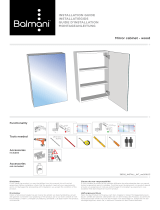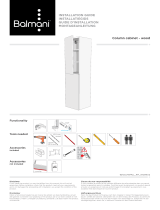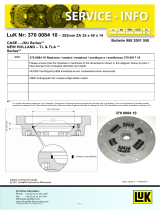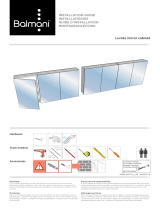
Bedieningshandleiding en
installatieinstructies
Operation manual and installation
instructions
Bedienungshandbuch und Einbau-
anleitung
Manuel d’utilisation et
d’installation
Manual de manejo y instrucciones
de instalación
Manuale per l’uso e
istruzioni per il montaggio
3
4
5
6
7
8
Luiken (Vluchtluiken en ventilatieluiken)
Hatches (Escape Hatches and Ventilation Hatches)
Luke (Vordeckluke und Ventilationsluke)
Capots (Capots de pont et capots de ventilation)
Escotillas (Escotillas de escape y escotillas de ventilación)
Boccaporti (Passouomo e portelli di ventilazione)
Copyright © 2017 Vetus b.v. Schiedam Holland
070107.02
LIBERO
PLANUS
Page is loading ...
Page is loading ...

4070107.02
vetus®Hatches
ENGLISH
1 Introduction
This Manual applies to the following Vetus Hatches type:
- Libero (Escape, deck and ventilation hatches)
- Planus (Escape, deck and ventilation hatches)
For drawings see pages 9 and 10.
2 Operation
2.1 Opening
• Release the clamp if locked, see Drawing 1 - (1).
• Turn the clamps quarter of a turn and push the hatch open. The
clamps can also be opened from the outside.
• Lock the hatch in the open position with the knob on the catch.
PLANUS hatches and LIBERO ventilation hatches are not equipped
with a catch, these hatch remain open in any position due to its
clamp hinges.
2.2 Ventilation
• Open the hatch about 1 cm (3/8”) and turn the clamp back to the
closed position; the hatch is now locked in the ventilation posi-
tion, see Drawing 1 - (3) and (4).
• Lock the clamp if required, see Drawing 1 - (2).
2.3 Closing
• Ensure that the clamps are in the ‘open’ position.
• Release the catch knob (Only Libero escape and deck hatches).
• Pull the hatch closed, turn the clamps a quarter of a turn and lock
them, see Drawing 1 - (2).
3 Safety
Escape hatch clamps must be unlocked when sailing, see Drawing
1 - (1).
Warning
Always check that catches have been properly locked! Unexpected
closing of a hatch can pinch ngers or toes.
4 Fitting
N.B.: The highest permitted design category or the highest permit-
ted area of use is stated on every hatch.
When tting the hatch, take the following into account:
- The hatch must open outward.
- Fit the hatch in a completely at surface! The hatch will never be
watertight when closed if tted in a curved surface!
First, ll out the curved surface with a close-tting wood frame.
- It is not possible to check that the hatch is watertight until it has
been completely built into the ship.
- When the hatch has not been tted in the ship, the opening and
closing of the hatch can damage the aluminium frame and/or
hinges when the hinges have been adjusted very tight!
- Even when the hatch has been built in, the hinges should not be
adjusted too tightly; this could damage the frame and/or hinge,
so that a good seal can no longer be guaranteed.
• Draw the hole to be cut out using the hatch deck frame, see Draw-
ing 2.
• Cut the hole in the ship by sawing for polyester, aluminium or
wood, or by acetylene cutting for steel.
• Remove all burrs carefully and smooth the edges.
Warning
Dust released when cutting and sanding glass-fibre reinforced poly-
ester is hazardous to lungs and eyes. So always wear a dust mask
and goggles when working with this material. Ventilate the working
area well.
• Position the hatch over the cut hole and mark the xing holes for
the frame, see Drawing 3. Drill the holes and remove any burrs.
• Apply a sucient amount of sealant to ensure a good seal, see
Drawing 4. Position the hatch on deck.
• Fixing the frame to the deck - deck material:
- Glass-bre reinforced polyester; use self-tapping panel screws,
4.2 mm diameter.
- Steel; use M5 nuts and screws.
5 Maintenance
• Clean the anodized or powder-coated aluminium proles regu-
larly; 2 to 4 times a year, depending on how dirty they get.
• Use only neutral cleaning agents. Do NOT use alkaline, acid and/
or abrasive cleaners.
• After cleaning, apply a thin coat of transparent wax for protection.
• Protect the sealing rubbers with talcum powder.
5.1 PLANUS hatches and LIBERO ventilation hatch-
es
Re-adjusting the hinges
Adjust the hinges if the hatch will not remain in the open position,
see Drawing 5.
6 Technical Data
Libero:
Deck frame, hatch frame : Aluminium (AlMgSi0.5)
Window : PMMA 10 mm
Planus:
Deck frame : Aluminium (AlMgSi0.5)
Window : PMMA 10 mm
Page is loading ...
Page is loading ...
Page is loading ...
Page is loading ...
Page is loading ...
Page is loading ...
Page is loading ...

vetus b.v.
FOKKERSTRAAT 571 - 3125 BD SCHIEDAM - HOLLAND
TEL.: +31 0(0)88 4884700 - [email protected] - www.vetus.com
Printed in the Netherlands
070107.02 2017-05
-
 1
1
-
 2
2
-
 3
3
-
 4
4
-
 5
5
-
 6
6
-
 7
7
-
 8
8
-
 9
9
-
 10
10
-
 11
11
-
 12
12
Vetus Type LIB Installation guide
- Type
- Installation guide
- This manual is also suitable for
Ask a question and I''ll find the answer in the document
Finding information in a document is now easier with AI
in other languages
- italiano: Vetus Type LIB Guida d'installazione
- français: Vetus Type LIB Guide d'installation
- español: Vetus Type LIB Guía de instalación
- Deutsch: Vetus Type LIB Installationsanleitung
- Nederlands: Vetus Type LIB Installatie gids
Related papers
-
Vetus FBH Installation guide
-
Vetus Type ALT Installation guide
-
Vetus Boat windows Installation guide
-
Vetus Boat windows Installation guide
-
Vetus HL12500A, HL12500B, HL24500A, HL24500B Operating instructions
-
Vetus HMB blind/mosquito screen combination Installation guide
-
Vetus Portholes PL-PM-PW-PX-PZ Operating instructions
-
Vetus Electric marine toilet type HATO Installation guide
-
Vetus Electric marine toilet type HATO2 Installation guide
-
Vetus Bulkhead mounted tank type WW Installation guide
Other documents
-
 Balmani 91174 Installation guide
Balmani 91174 Installation guide
-
 Balmani 91163 Installation guide
Balmani 91163 Installation guide
-
 LuK LUK370008410 Assembly Instructions
LuK LUK370008410 Assembly Instructions
-
 Balmani 87740 Installation guide
Balmani 87740 Installation guide
-
EDWARDS D16L-Fa LED Display Expander Installation guide
-
Koenic KWM 62212 A3 Owner's manual
-
Contura 690 & 690G Style Operating instructions
-
Kyosho No.40108 R/C SURFER 3 User manual
-
 Gimi 10140045 Datasheet
Gimi 10140045 Datasheet
-
Kyosho No.40110 R/C SURFER 4 Owner's manual
















